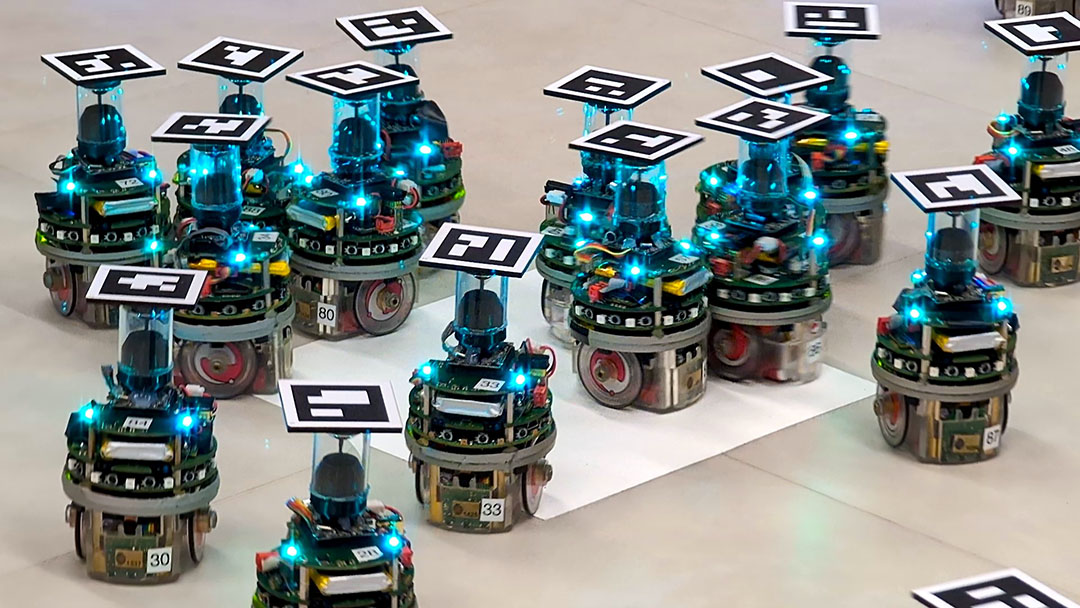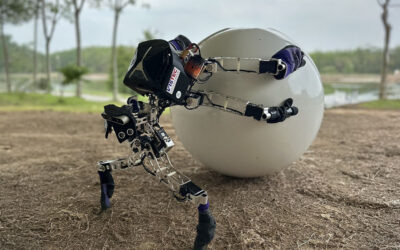Robots that perform tasks autonomously are becoming an increasingly important part of our lives, performing jobs that are too dangerous, too labor-intensive, or too time-consuming for humans to undertake.
Tasks performed by robots can range from the exciting, such as flying drones capturing incredible aerial footage, to the mundane, such as mowing lawns or vacuuming carpets. But the image of robots we have generally shows one unit working in isolation, and that is indeed how most robots today work. However, just as humans often achieve the best results when working in collaboration, scientists also think robots could work together to achieve more.
Large, self-organizing groups of robots can operate in unison to perform tasks that escape the capabilities of individual robots. These “robot swarms” could expand robotics beyond isolated solutions into large-scale, collaborative robotic services. That is the vision of many scientists, including a team of researchers behind a paper published in Advanced Intelligent Systems, who have applied a novel process to the realization of robot swarms.
“Designing robot swarms is challenging because, although the task and desired behavior are defined for the group of robots as a whole, each robot still needs to be programmed individually,” said David Garzón Ramos, researcher at the Université libre de Bruxelles. “As of today, there is no established method to tell the individual robot what it should do so that the desired collective behavior emerges in the swarm.”
Garzón Ramos explained that this means designing swarm behaviors currently relies on the manual programming of each robot in a swarm, which is a labor-intensive process requiring the implementation, testing, and refining of control software.
“This approach is not only time-consuming but offers limited reproducibility and versatility across different tasks,” Garzón Ramos continued. But there is an alternative.
Wheeled robots running on automatic
To tackle the problem of programming swarm robots, the team adopted an approach called “automatic design,” an alternative approach to manually programming the robots individually that uses a computational optimization process to produce the control software the units require.
When adopting this approach, the designer specifies the task the robots are to perform, and an optimization algorithm simulates and evaluates potential solutions to their mission. The algorithm also searches for the most effective software configuration for the robots, one which will enable them to achieve their goal without human intervention during the design process.
“The revolutionary aspect of automatic design lies in its ability to generate the control software the robots require without requiring an expert designer,” Garzón Ramos continued. “A user can specify the task, and the automated process programs the swarm to perform it efficiently. This has broad potential, offering general applicability and reproducibility.”
This isn’t the first time that automatic design has been applied to robotic swarms, with prior studies demonstrating the ability of this approach to outperform human designers in developing robots for certain tasks. The method has been particularly effective in the development of robots tasked with missions that require collaborative exploration and coordination via communication.
“In our study, we focused on designing robot swarms that perform tasks sequentially, a complex challenge that had not been fully addressed in prior research,” said Garzón Ramos. “In this design problem, each task in the sequence is a design criterion to be considered during the optimization process, and the objective is to produce control software that allows the robots to satisfactorily perform all tasks in the sequence.”
The team adopted an automatic design process called “Mandarina” to develop control software for a swarm of 20 small wheeled “e-puck” robots, each equipped with an omnidirectional camera to identify each other and LED lights to communicate with the swarm. The e-pucks could also “read” the color of their environments, using these as cues to adapt their behavior.
“In our experiments, we defined a set of 15 missions, each composed of different tasks that the swarm of e-pucks had to perform sequentially,” Garzón Ramos said. “The main challenge was for the automatic design process to produce a single instance of control software that could maximize performance across both tasks. This required creating collective behaviors that could balance the performance requirements of each task concurrently. Using Mandarina, we generated control software for these 15 missions, testing it initially in simulation and then verifying the best instances with physical robots.”
A developing field
The team found that in the 15 missions, Mandaria produced control software that allowed the swarm of e-pucks to perform the missions assigned by the scientists, such as foraging and gathering objects, satisfactorily. They then compared Mandarina’s performance to a set of baseline methods, finding this automatic design process outperformed all of them. However, it is still very early stages for swarm robotics.
“Swarm robotics is still a developing field, and only a few real-world examples show large groups of robots working together autonomously. Our work demonstrates that automatic design can tackle increasingly complex problems, specifically where multiple criteria define what we want the robots to do,” Garzón Ramos said. “In real-world applications, we expect swarms to operate under various constraints — not only related to how they perform tasks but also considering how they interact with the environment and, potentially, with people.”
The researcher added that to deploy this approach on a wide scale, future research must explore how these methods can be employed in these realistic settings, environments that may have to consider many design criteria at once. The researchers aim to develop “out of the box” systems that require little human interaction to adapt to diverse tasks and criteria, an adaptability that could, in the future, allow swarms to perform tasks that require addressing technical precision concurrently with social and environmental responsibility.
“We envision a future where robot swarms, or other forms of collective robotics, provide essential services in daily life,” Garzón Ramos concluded. “For example, robot swarms could handle tasks like city cleaning or environmental maintenance, helping keep urban areas clean or monitoring ecosystem health.
“While it may seem simple to deploy a large group of robots for such tasks, effectiveness requires coordination and cooperation to optimize their performance as a team.”
Reference: David Garzón Ramos, Mauro Birattari, et al, Automatic Design of Robot Swarms under Concurrent Design Criteria: A Study Based on Iterated F-Race, Advanced Intelligent Systems (2024). DOI: 10.1002/aisy.202400332

















